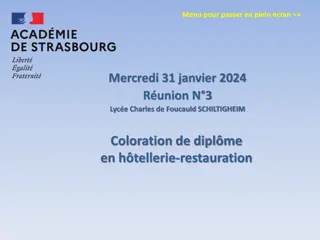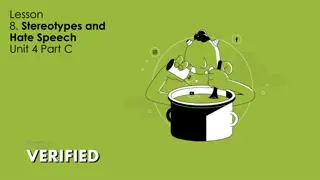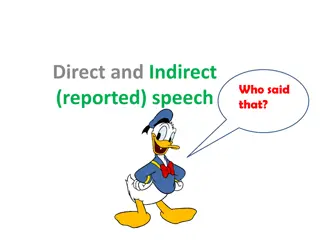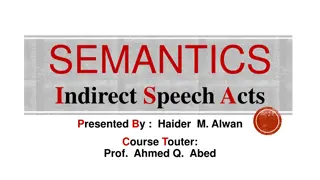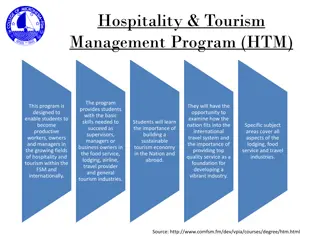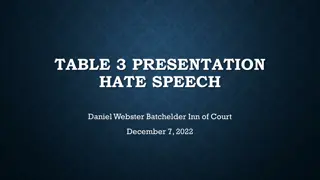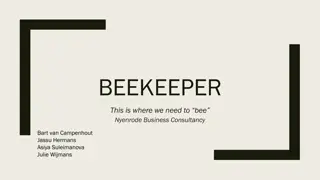Analysis of Speech Acts in Hospitality Situations
Examining the role of linguistic forms in hospitality interactions reveals the significance of language in shaping experiences. Research delves into greetings, invitations, and imperative structures, highlighting how linguistic choices impact the perception of hospitality. The analysis emphasizes the interplay between language use and hospitality behaviors, providing insights into the nuances of verbal interactions in creating hospitable environments.
Download Presentation

Please find below an Image/Link to download the presentation.
The content on the website is provided AS IS for your information and personal use only. It may not be sold, licensed, or shared on other websites without obtaining consent from the author.If you encounter any issues during the download, it is possible that the publisher has removed the file from their server.
You are allowed to download the files provided on this website for personal or commercial use, subject to the condition that they are used lawfully. All files are the property of their respective owners.
The content on the website is provided AS IS for your information and personal use only. It may not be sold, licensed, or shared on other websites without obtaining consent from the author.
E N D
Presentation Transcript
faculteit der letteren | 1 Observing speech acts in hospitality situations. The role of the linguistic form Leanne Schreurs 12th International Columbia School Conference on the Interaction of Linguistic Form and Meaning with Human Behavior Columbia University February 14-16, 2015
faculteit der letteren | 2 What is hospitality? SaxionHospitality Business School (the Netherlands): Hotel & Tourism Management. Methods of data collection and analysis need to be broadened (cf. Lashley & Morrison 2000; Robinson & Lynch 2007). The lack of linguistic research on how experiences of hospitality are shaped is unfortunate, as the experience of hospitality relies heavily on verbal social interactions (Robinson & Lynch 2007). An analysis of the linguistic forms related to hospitality.
faculteit der letteren | 3 Qualitative analysis of a hospitality situation (1) Ah de la casa! grita en cuanto arrima. Buenos d as, se or Don Jos Mar a contesta Don Rufo saliendo al corredor, muy hospitalario y atento . Por qu no se desmonta y se cuela? Con mucho gusto, si lo permite el amigo. Hi there! he screams, while arriving [at the house]. Good morning, Mr Sir Jos Mar a answers Sir Rufo while coming to the corridor, very hospitable and polite . Why don t you get off [the horse] and come in? With pleasure, if my friend allows me to do so. (Carrasquilla 1974 [1928]: 158)
faculteit der letteren | 4 Speech acts and linguistic forms Speech acts (Searle 1969): 1. To greet Buenos d as, se or Don Jos Mar a. Good morning, Mr Sir Jos Mar a. Greeting, wishing the other person a good day; Formal address terms; Double proper name. 2. To invite Por qu no se desmonta y se cuela? Why don t you get off [the horse] and come in? Interrogative sentence; Negation; Verb conjugations in 3rd person singular; Indicative mood.
faculteit der letteren | 5 Invitation speech acts: the imperative Two linguistic structures to indicate invitations: 1. Imperative, in two forms: a. informal, 2nd person singular/plural, indicative mood, e.g., pasa come in b. formal, 3rd person singular/plural, subjunctive mood, e.g., pase (usted) please come in Imperative forms may also convey commands or requests. The imperative as an invitation: repetition of the verb form, e.g., fuma, fuma of course you may smoke (Matte Bon 1995 [1992]: 94). The degree of formality is not necessarily related to a certain degree of hospitality, but it seems that the formal construction has a higher connotation with hospitality than the informal one.
faculteit der letteren | 6 Invitation speech acts: question + negation 2. Question as a proposal: a. negation b. indicative mood Invitational structure to propose an activity to the interlocutor (Matte Bon 1995 [1992]: 319). The hospitality situation indicates that: hospitality may be related to different linguistic systems interacting with the context; greetings and invitations are speech acts that may be characteristic to hospitality situations; the linguistic forms that may intervene in polite hospitality situations possibly are formal address terms, verb mood and interrogative structures with a negation.
faculteit der letteren | 7 Quantitative analysis Distribution analysis of scene types and linguistic forms to observe general tendencies Results restricted to La Marquesa de Yolomb (The Marchioness of Yolomb ; Carrasquilla 1974 [1928]) they cannot be generalized to hospitality situations they serve to elaborate upon the hypothesis that linguistic forms may function as hints (Diver 1975) to hospitality.
faculteit der letteren | 8 Quantitative analysis: relationships and situations Relatives conjugal partners grandparent <> grandchild Non-relatives acquaintances Conflictive Non-conflictive discussions encounters boss <> servant employer <> employee pleasant conversations quarrels Table 2. Types of situations parent <> child parent in law <> child in law friends godparent <> godchild godparents inhabitants parents in law siblings siblings in law parent's sibling <> sibling's biological offspring Linguistic forms: forms of address verb mood mayor <> inhabitant neighbours strangers Table 1. Types of social relationships
faculteit der letteren | 9 Proposition 1 Given the expectation that hospitality situations are more likely to occur among non-relatives than among relatives, it can also be expected that conflictive situations are more likely to occur among relatives than among non-relatives. (2) D jate de pendejadas, que ya no eres ninguna ni a de teta! Pero, si no lo entiendes, oye: [ ] aqu no debo traer m s mujer que la leg tima; y yo no puedo dormir solo porque me da mucho fr o. Asina es la cosa, su Merced? Pues, entonces no se ponga a esperar un mes: cuando el palomito arrastra el ala, hay que buscarle su palomita, porque persigue las gallinas. Perra irrespetuosa! Te vas de aqu agora mesmo! Don t be silly, you re not a little child anymore! But, if you don t understand, listen: [ ] I should not bring here any other woman than the legitimate one; and I can t sleep alone because I get cold. That s how it is, your Mercy? So, then don t wait a month: when the pigeon drags his wings, one must look for his mate, because otherwise he ll chase other hens. Disrespectful brat! Leave immediately! (C. 1974 [1928]: 166-167)
faculteit der letteren | 10 Prop.1: relationships in relation to situations Non-conflict situations 466 X2: 356,8 p<0,001 Relatives Conflict situations 354 Total 820 77% 28% 39% Non-relatives 108 1187 1295 23% 72% 61% Total 462 1653 2115 100% 100% 100% Table 3. Distribution of social relationships across situations
faculteit der letteren | 11 Proposition 2 T 73 12 V T Vos Usted Us a Su merced 137 11 140 Vuestra excelencia 1 Total N Table 4. Classification of the forms of address 85 289 The expectation is that V-forms are more likely to occur in hospitality situations, and therefore among non-relatives, then with relatives, who will show a relative preference for T-forms.
faculteit der letteren | 12 Prop.2: forms of address in relation to relationships X2: 5,6 p<0,05 V Relatives 118 Non-relatives 171 Total 289 72% 82% 77% T 47 38 85 28% 18% 23% Total 165 209 374 100% 100% 100% Table 5. Distribution of forms of address across relationships
faculteit der letteren | 13 Proposition 3 If V-forms are related to hospitality situations and these situations are likely to occur in non-conflictive situations, we expect to see a relative preference of V-forms in non-conflictive situations, as opposed to T-forms for conflictive situations. (3) Qu es lo que dice, Naciancena? estalla Do a Antonina . H game el favor de repetir, porque no le entiendo. Eh, Antoninita! Se viene a hacer de las nuevas, usted, que no les tapa nada! [ ] La materia corrompida la tendr s vos y toda tu ralea, zamba atrevida y leng ilarga! What are you (V) saying, Naciancena? Mrs Antonina bursts out . Please, do (V) me the favor of repeating, because I don t understand you (V). Hey, Antoninita! You re (V) of the new kind, you (V) don t cover up anything from them![ ] You (T) and all your (T) kind of people are the corrupted dirty ones, insolent gossip half-breed! (C. 1974 [1928]: 379)
faculteit der letteren | 14 Prop.3: forms of address in relation to situations X2: 11,7 p<0,001 V Conflict situations 65 Non-conflict situations 224 Total 289 65% 82% 77% T 35 50 85 35% 18% 23% Total 100 274 374 100% 100% 100% Table 6. Distribution of forms of address across situations
faculteit der letteren | 15 Proposition 4 If hospitality is more related to non-relatives, and the subjunctive mood indicates the relevance of an alternative (De Jonge 2004, Dreer 2007), we should observe a relative preference for the use of subjunctive by non-relatives and indicative by relatives. (4) Algo semejante me pasa con su sobrino. Con zcalo o no, voy a contar todas sus fechor as y las de su abuelo Moreno. Ya l me dio permiso. Valientegracia! Hasta premio le da. Pero vea una cosa, Orellana: yo me atrevo a suplicarle que cuente los milagros sin nombrar los santos. Con mucho gusto, Marquesa. Basta con que usted me lo recomiende. Something similar happens to me with regard to your nephew. It doesn t matter if you know him or not, I m going to tell all his misdeeds and that of his grandfather Moreno. He already gave me permission. How funny! He will even reward you for that with a price. But please see (S), Orellana: I dare to beg you to tell (S) the miracles without revealing the names of the saints. With pleasure, Marchioness. It is enough that you recommend (S) me to do so. (C. 1974 [1928]: 526-527)
faculteit der letteren | 16 Prop.4: verb mood in relation to relationships X2: 7,7 p<0,01 Indicative Relatives 435 Non-relatives 548 Total 983 70% 63,5% 66% Subjunctive 183 315 498 30% 36,5% 34% Total 618 863 1481 100% 100% 100% Table 7. Distribution of verb mood across social relationships
faculteit der letteren | 17 Proposition 5 The expectation is that there is a preference for the subjunctive mood in non-conflict situations, since both would be the place for hospitality situations to occur. X2: 0,9 p<0,4 Indicative mood Non-conflict situations 760 Conflict situations 223 Total 983 64% 67% 66% Subjunctive mood 124 374 498 36% 33% 34% Total 347 1134 1481 100% 100% 100% Table 8. Distribution of verb mood across situations
faculteit der letteren | 18 Conclusion Preliminary results of the analysis of linguistic forms in relation to hospitality. Qualitative analysis: address terms, verb mood and interrogative structures with a negation are linguistic forms that may intervene in hospitality situations. Quantitative analysis: hospitality situations are most commonly associated with non-relatives and non-conflict situations; non-relatives and non-conflict situations have a preference for V- forms over T-forms; non-relatives show a relative preference for the subjunctive mood; non- conflict situations do not show a preference for the subjunctive mood. Linguistic forms 1. forms of address 2. verb mood work-in-progress 3. questions 4. negation Suggestions for other variables and for the experiment?
faculteit der letteren | 19 References Brown, Roger and Albert Gilman. 1960. The Pronouns of Power and Solidarity. In: Sebeok, Thomas A. (ed.). Style in Language.Cambridge, MA, MIT Press: 253-276. Carrasquilla, Tom s. 1974 [1928]. La Marquesa de Yolomb , edited by Kurt L. Levy. Bogot : Instituto Caro y Cuervo. De Jonge, Bob. 2004. The Relevance of Relevance in Linguistic Analysis: The Case of Spanish Subjunctive Mood. In: Contini-Morava, Ellen, Robert S. Kirsner, and Betsy Rodr guez Bachiller (eds.). Cognitive and Communicative Approaches to Linguistic Analysis. Amsterdam, John Benjamins: 205-218. Diver, William. 1975. Introduction. In: CUWPL 2, pp. 1-20. Dreer, Igor. 2007. Expressing the same by the different: The Subjunctivevs the Indicative in French. Amsterdam: John Benjamins. Lashley, Conrad, Paul Lynch, and Alison J. Morrison. 2007. Hospitality: A Social Lens. Amsterdam; Oxford: Elsevier. Matte Bon, Francisco and I igo S nchez Pa os. 1995 [1992]. Gram ticaComunicativadel Espa ol ; T. 1: De la Lenguaa la Idea. - T. 2: De la Idea a la Lengua. Madrid: Edelsa. Robinson, Martha G. and Paul A. Lynch. 2007. Hospitality through Poetry: Control, Fake Solidarity, and Breakdown. International Journal of Culture, Tourism and Hospitality Research 1 (3): 237-246. Searle, John R. 1969. Speech Acts: An Essay in the Philosophy of Language. Cambridge: Cambridge University Press.
faculteit der letteren | 20 Frequencies Form of address V N % 77 Verb mood Indicative N % 61 289 782 T 85 23 Subjunctive 498 39 Total 374 100 Total 1280 100 Tabel 1. Frequency of Forms of address Tabel 2. Frequency of Verb mood Speech situations Conflict situation Non-conflict situation Total Social relationships Relatives Non-relatives N % 22 N % 39 61 462 820 1298 1653 78 Total 2118 100 2115 100 Tabel 4. Frequency of Social relationships Tabel 3. Frequency of Speech situations
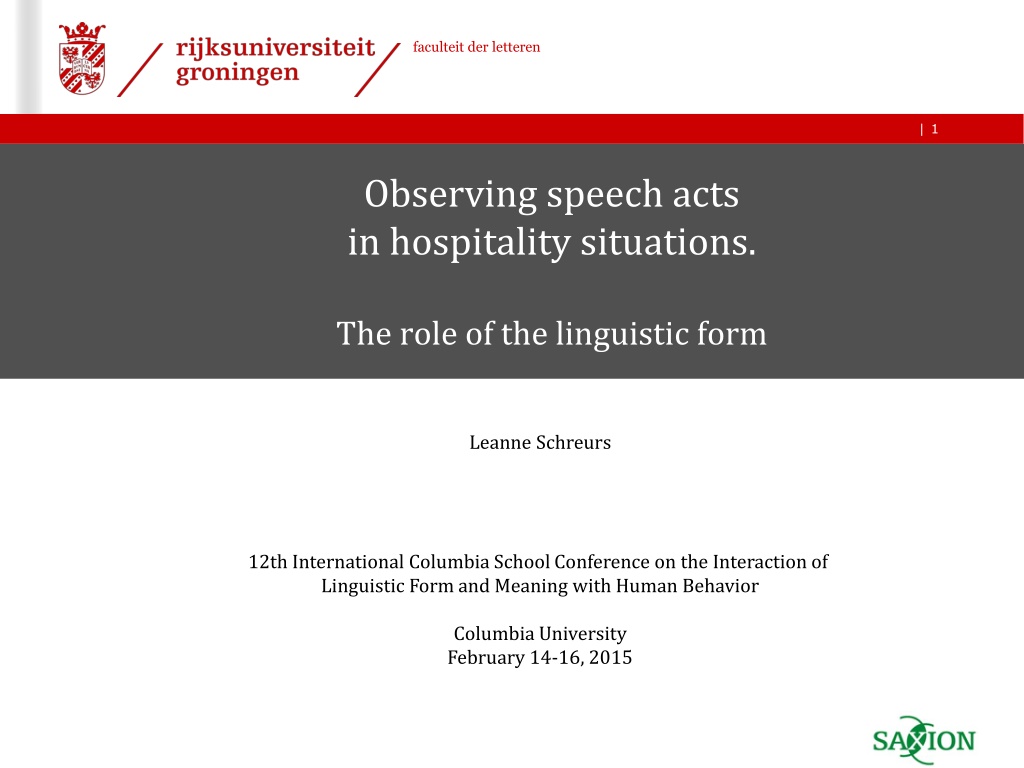
 undefined
undefined










